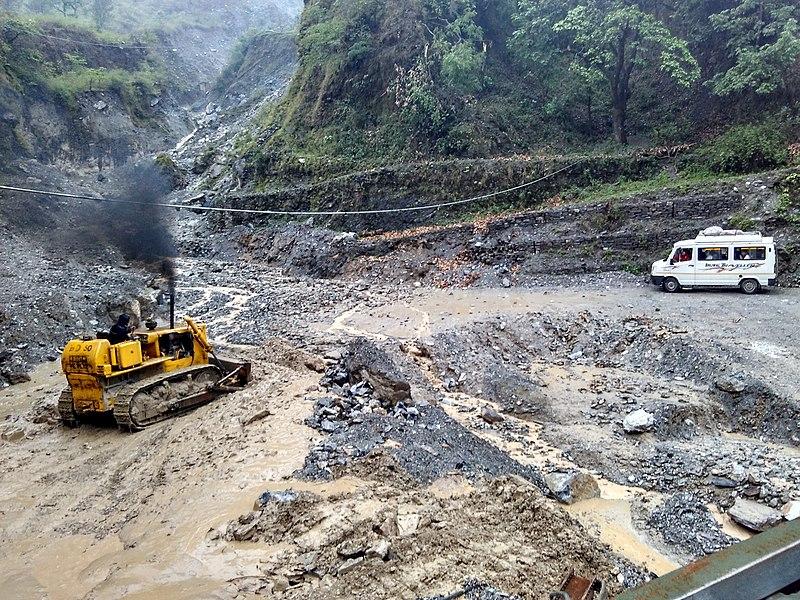Climate Change Explains the Unprecedented Havoc Created by Retreating Monsoon in Uttarakhand

Road affected by flash flood, near Nachni, Pithoragarh District, Uttarakhand
Natural disasters and calamities are not new to the Himalayan state of Uttarakhand. Every year, the monsoon triggers a series of incidents involving cloud bursts, landslides and flash floods. In the past during the retreat of monsoon, however, this phenomenon was not seen, something which the state witnessed this year. The state saw incessant rainfall beginning Sunday night that went on till Tuesday. So far in October, Uttarakhand has recorded a whopping 192.6 mm of rainfall against 31.2 mm last year. Out of this, 122.4 mm of mm was recorded in 24 hours itself. Reportedly, around 52 people lost their lives on account of heavy rainfall and a series of landslides. The worst affected district was Nainital that saw the highest death toll of 28 deaths.
Atul Satti, a local environmental activist is of the opinion that there has been a manifold increase in the tourist influx over the years, and this is a factor in the disaster unfolding in the state. Roughly counting, the state used earlier to host around 6 lakh tourists per year, which has now increased to over 15 lakhs. With this, there has been an increase in vehicular pollution, river pollution, construction activities, and commercialization, all of which leads to the destruction of green cover and other changes. “All these factors have contributed to the increase in temperatures along with a change in rainfall pattern. We now see incessant rains that go on for 2-3 days at a stretch; then there are several days when the state is left high and dry. Also, during the 1980s and 1990s, snowfall was a prominent feature between December 20-25 in the Joshimath region. But that changed over the years, with snowfall even giving a miss to the region,” he said. Earlier also, the effects of weather-related calamities were aggravated due to unsustainable construction activities, changes in water channels, and indiscriminate road-building in fragile areas.
Weather scientists and experts are also putting the onus of these untimely showers over the state to the extended stay of the southwest monsoon this year over the country. The presence of the monsoon current over the region means the presence of an abundance of moisture over the landmass, keeping weather conditions favourable for the formation of weather systems.
Experts opine that low-pressure areas travelled all along the Northern Limit of Monsoon (NLM), which was then passing through parts of Central India. The system later moved north towards Uttarakhand and then recurved towards Uttar Pradesh. Also, post the retreat of the monsoon, dry northwesterly winds start blowing over north India. But the presence of multiple weather systems led to a change in the wind pattern and we could see strong humid easterly winds all along the Indo-Gangetic plains with a depth of more than 8000 ft. According to GP Sharma, president of the meteorology and climate change department at Skymet Weather, “It is very much evident that, had the monsoon departed timely, we would not have seen such torrential rains. Weather conditions were very favourable for such heavy precipitation on account of multiple weather systems coming together. While there was a western disturbance up in the hills, two low-pressure areas were seen over Madhya Pradesh and the Bay of Bengal, respectively. However, what prompted these systems was the delayed withdrawal of monsoon. Usually, weather systems do not travel inland, especially over the places from where monsoon has retreated. And since by this time the NLM was still passing through Madhya Pradesh, these low-pressure areas tended to travel deep inside the land.”
He further added, “Not only this, the low-pressure area over Madhya Pradesh interacted with the western disturbance over the northern Himalayas and pulled it down. This not only enhanced the rainfall manifold over Uttarakhand but resulted in early snowfall over parts of Jammu and Kashmir. Since there is rare development of any weather system over the plains during this time of the year, we do not see much impact of any western disturbances over the northern states other than some light showers. Usually, we start witnessing changes in the track of western disturbances by the end of October. Both the intensity and frequency of western disturbances increase by November only.”
Both the low-pressure areas travelling in the Bay of Bengal were the remnants of tropical storms Lionrock and Kompasu in the Pacific Ocean which re-emerged in Indian seas and gathered strength. While the former travelled to Madhya Pradesh, the latter one affected West Bengal, Bihar and entire Northeast India. The late withdrawal of southwest monsoon is a new normal, courtesy of climate change.
The latest report by the United Nations-led Intergovernmental Panel on Climate Change (IPCC), the ‘Sixth Assessment Report Climate Change 2021’ has already indicated that increasing global temperatures are changing monsoon patterns across Southeast Asia. A warmer climate will intensify very wet, very dry weather and climate events and seasons, with implications for flooding or drought. The location and frequency of these events depend on projected changes in regional atmospheric circulation, including monsoons and mid-latitude storm tracks. Monsoon has been breaching its normal withdrawal date for many years now. With this, the state-run India Meteorological Department (IMD) had also revised the commencement date of the Monsoon withdrawal from September 1 to September 17. Normally, the withdrawal process competes by October 15, which has not been the case for the last decade.
“We are now in the firing range of climate change, which has clearly altered the frequency, timing and track of weather systems during, before and after the monsoon. We are in the second half of October and weather systems are still penetrating deep inside till Maharashtra,” added GP Sharma. However, the mass destruction caused by inclement weather conditions is not only because of the climate crisis. It is quite evident that development plans and human interference are not complimenting the ecological balance of Uttarakhand. Professor YP Sundriyal, head of geology department at HNB Garhwal University further threw light on the matter saying, “Higher Himalayas, both climatically and tectonically, are highly sensitive, so much so, that at first stance construction of mega hydro-projects should be avoided. Or else they should be of small capacity. Secondly, the construction of roads should be done with all scientific techniques. At present, we just see roads are being made or widened without taking proper measures such as no slope stability, lack of good quality retaining wall and rock bolting. All these measures can restrict the damage done by landslides up to some extent.”
He further added, “There is a huge gap between planning and implementation. For instance, rainfall patterns are changing, temperatures have been increasing along with extreme weather events. Policymakers should be well versed in the geology of the region. There is no denying the fact of development is required, but hydropower plants, especially in higher Himalayas should be of less capacity. Policy and project implementation should consist of local geologists who understand the terrain well and how it responds.”
Get the latest reports & analysis with people's perspective on Protests, movements & deep analytical videos, discussions of the current affairs in your Telegram app. Subscribe to NewsClick's Telegram channel & get Real-Time updates on stories, as they get published on our website.
























